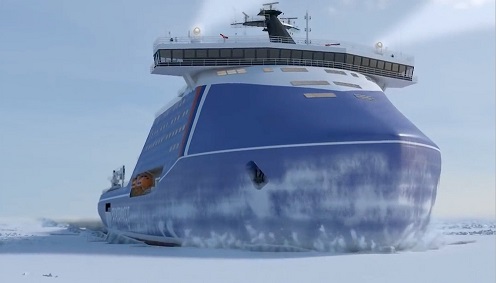
- Главная
- Журнал «ПортНьюс»
- Журнал №5 (2020)
- The cost of the Northrn Sea Route
The cost of the Northrn Sea Route
 Construction of one Leader class icebreaker will consume about 10% of resources allocated for the support of economic amid the pandemic. There also numerous privileges and measures intended to support the Arctic projects. Is it worth the cost? Strategic development of the entire country is at the stake.
Construction of one Leader class icebreaker will consume about 10% of resources allocated for the support of economic amid the pandemic. There also numerous privileges and measures intended to support the Arctic projects. Is it worth the cost? Strategic development of the entire country is at the stake.
Atomflot has recently announced signing of a contract with Shipbuilding Complex Zvezda on construction of the lead nuclear-powered icebreaker estimated at almost RUB 130 billion. The icebreaker is to be built before 2027 with two more ships of the series to be build by 2035. Even taking into account the lower cost of serial ships as compared with that of the lead unit, total expenses will hardly be below RUB 300 billion. Besides, Russian shipbuilding is known for being prone to increase the cost of contracts due to various reasons (sometimes beyond the industry control). For example, RUB 300 billion makes about a quarter of the amount earmarked so far for the support of Russia’s economy amid the coronavirus pandemic.
With the allocations for construction of five nuclear-powered icebreakers of LK-60 design (about RUB 250 billion), numerous privileges and subsidies for NOVATEK, expenses for construction of the auxiliary and service fleet total investments of the state in the Arctic transport infrastructure will easily exceed RUB 1 trillion.
However, it should be taken into consideration that those resources will not be spent simultaneously, it will take the coming 15 years. Annual expenditures for the Arctic will not be as impressive – they will be below RUB 100 billion with regard to unreceived revenues due to tax privileges. Anyway, that is a fair amount when compared to health expenditure that are bellow RUB 500 billion per year.
What for?
The above-mentioned calculations raise quite a logical question: What can the Arctic give to the country’s economy?
In fact, Russia is still a country with a high share of commodities exports. With the depletion of currently used hydrocarbon fields it is important to develop new ones and most resources are located in the Arctic zone.
In his interview with IAA PortNews, Aleksandr Krutikov, Deputy Minister for the Development of the Russian Far East and Arctic, said that the total amount of investments in large-scale hydrocarbon projects alone would make about RUB 15 trillion.
The first and the key hope is export of liquefied natural gas (LNG). Actually, the growth of LNG trading worldwide has changed the entire gas market. Focused on diversification of supplies, Europe actively acquires LNG as an alternative to Russia’s pipeline gas. Besides, with LNG we can reach out to the markets not connected with us by pipelines. Unlike the market of pipeline gas where Russia has always been holding its leadership, the situation is different in the market of LNG. The leaders are Qatar (which failed to build a pipeline to Europe but succeeded in LNG supplies), Australia and the USA. It is Russia’s Arctic projects that let the country take the fourth place in production of LNG in 2019, up from the end of the global rating in 2018. Large-scale LNG exports will let Russia retain its position in the global gas market preventing the competitors from too extensive diversification of customers. The more so as gas liquefaction in the Arctic low temperature conditions is easier than in the hot climate of Qatar and Australia. Yet, it is transportation that is a challenge. A powerful fleet of icebreakers is required for that purpose.
As for oil, the most promising are the Payakhskoye field being developed by AO Neftegazholding and the Vankor field of Rosneft, Maxim Kulinko, Deputy Head of the Northern Sea Route Directorate – Head of Rosatom’s Department for Development of NSR and Costal Territories, told in his interview with IAA PortNews.
Albeit less promising, there are projects on production and exports of coal. Although coal mining in the Arctic is expensive, the demand for it is decreasing in Europe and its production and transshipment can have a negative impact on the environment, VostokCoal and Severnaya Zvezda have some plans on development of coal fields in the Arctic.
The Northern Sea Route can be also used for carrying cargo from hinterland production centers. For example, up to 1 million tonnes of Russian grain from the Omsk and Kurgansk Regions bound for customers in the South East Asia is to be transshipped annually via the port of Sabetta (Yamal).
In the long term, we can also count on development of transit cargo transportation along the Northern Sea Route. Ships with ice class of Arc4 and higher are needed for that purpose.
“As for the international transit, I think it is the prospect for 2030 when we will show by an example of our cargo ... navigation stability. Then, others will probably catch up, though not quickly of course. As for the summer-autumn navigation, I expect the annual level of 3-5 million tonnes that can be achieved in the coming three-five years. But then again we will need at least Arc4 class ships of large capacity which are not that many in the world”, Vyacheslav Ruksha, Deputy Director of Rosatom - Director of Rosatom’s Northern Sea Route Directorate, said in his interview with PortNews-TV at the 3rd International Congress “Hydraulic Engineering Structures and Dredging”.
When speaking about the expenditures for the Arctic, it should be taken into account that construction of icebreakers and other Arctic class ships and facilities, dredging of water areas, development of terminals, railway and river infrastructure ensure loading of several industries and create a multiplicative effect for the economy. It is also crucial to ensure import substitution and localization of production facilities so that state resources did not drain from the country. However, import substitution is a different story.
Vitaly Chernov







